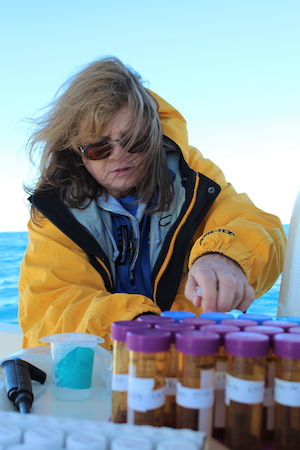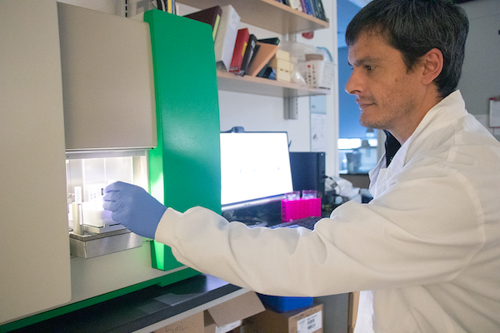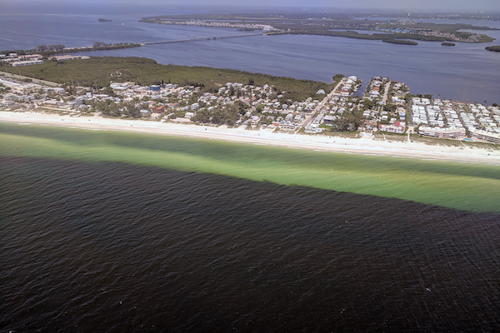Study Probes Marine Virus Impacts on Harmful Algae
In 1648, Spanish sailors in the Gulf of Mexico recorded sighting a "mountain of dead fish near the coast." Today, researchers believe that this fish kill was likely caused by Karenia brevis – the same species of toxic algae that can multiply and create a harmful algae bloom, affecting the Gulf of Mexico nearly every year.
"Harmful algal blooms are a real problem, and we know that for several species of algae, blooms are becoming more prevalent and more persistent," Senior Research Scientist Joaquín Martínez Martínez said. "Their abundance is the product of so many different moving pieces, including everything from nutrient levels to ocean currents. The only way to truly determine how these systems function is through a deeply holistic approach."
Like plants on land, algae in the ocean support ecosystems by processing nutrients and feeding animals — but some also produce toxins that poison fish and other animals. When large numbers of these algae bloom, toxins can move up the food chain and accumulate to harmful levels in shellfish, fish, and mammals.
From 2017 until 2019, an unusually prolonged bloom of Karenia brevis plagued Florida, harming the state's coastal economies, marine life, and residents' health. The timing and locations of Karenia brevis blooms in the Gulf of Mexico are somewhat predictable, but little is known about exactly what triggers them – and even less about what causes their demise. Martínez Martínez, an expert in marine virus ecology, believes that interactions between viruses, algae, and bacteria may hold the key to the complex system of a bloom.

"So far, the effects of viruses are missing from harmful algal bloom research, and we think this information might be the missing link needed to untangle their effects," Martínez Martínez said. "Our goal is to provide an in-depth, fundamental understanding of blooms that can help practitioners manage and potentially even predict Karenia brevis blooms in the Gulf of Mexico."
Marine viruses are ubiquitous throughout the global ocean, and a single drop of seawater can contain thousands of them. It can also contain thousands of algae and bacteria, which interact with each other as well as the viruses.
The convoluted relationships among these three types of organisms are further complicated by the fact that each of the interactions, including infection by viruses, can create both positive and negative consequences for the organisms – and for their ecosystems. Martínez Martínez hopes to unravel these multidirectional relationships in the Gulf of Mexico, and determine how they shape Karenia brevis blooms.
He is working with six other researchers who are uniting their diverse expertise to bring a holistic perspective to Florida red tide research. Over this five-year project, the team's comprehensive approach will combine weekly sampling along the southwest Florida coast, research cruises into the Gulf of Mexico, and laboratory experiments. They will also mine historical data and develop models that can predict when Karenia brevis blooms will progress through different stages – and hopefully reveal what causes a bloom to end.

"Nutrient levels explain part of the story, and ocean physics explain another part, but the only way to really understand the Florida red tide is to look at it from all different angles," said Cynthia Heil, the project lead and director of the Red Tide Institute at Mote Marine Laboratory in Florida. "In the ocean, each component of the ecosystem interacts with everything else, so it would be an impossible task to understand blooms without such an interdisciplinary team studying these biological, chemical, and physical interactions."
Karenia brevis is an especially complicated species to pin down because it is able to utilize both simple and chemically complex nutrients to grow. It is also a mixotroph – able to both create its own food through photosynthesis, and to consume other organisms. This single-celled alga can produce a suite of toxins, and the type produced changes based on which bacteria are present in the environment.
During the 2017 to 2019 bloom in Florida, Karenia brevis' toxins killed nearly 600 sea turtles, and more than 200 manatees and 150 dolphins. Beyond this environmental destruction, the bloom also hurt commercial fisheries and cost the state millions of dollars in health care, loss of tourism, depreciated property values, and much-needed emergency funds.
The research team plans to make the wealth of data generated over the five years of this project available to other researchers. They hope their work can provide a foundation for understanding other types of harmful algal blooms, and their possibly pivotal interaction with marine viruses around the world.
"Harmful algal blooms are a global problem for coastal ecosystems and communities, and we have the opportunity to make a significant impact with this work," Martínez Martínez said. "When we put the complex picture of harmful algal blooms together, this project can truly be transformative for our understanding and the future management of these events."
The first image is courtesy of Vince Lovko from Mote Marine Laboratory, and the second is courtesy of Hayley Rutger from Mote Marine Laboratory.

